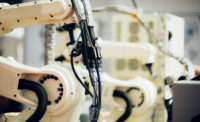Before determining which industrial guarding method is best, it’s extremely important to understand the advantages and disadvantages of each. Industrial guarding is an exercise in understanding and applying codes and regulations, assessing risk, applying prevailing machine guarding choices and validating the safety system and its components. Although many guarding methods and products are available, not all can be applied universally.
Presence-sensing devices
Light curtains, laser scanners and other presence-sensing devices are a commonly used and widely accepted method of machine perimeter guarding and point of operation guarding. Light curtains can be found in nearly every type of manufacturing facility from Tier 1 automotive plants to small machine shops and fabrication facilities. Presence-sensing devices provide safety by halting machine operations if an object breeches the predetermined safety zone. Presence sensors are practical options. Be aware that light curtains do little to prevent exposure to secondary hazards in applications that create flying debris, flash from a welding process, sparks, splash or smoke.
Automated barrier doors
Fast-acting automated barrier doors and roll-up curtains coupled with safety interlocks can provide the same level of electronic safety (up to PLe per EN ISO 13849-1 when integrated properly). They are a reliable high-speed movable barrier for point-of-operation guarding. The physical separation provided by these types of devices provides an additional level of safety. Automated barrier doors restrict access to the process; contain secondary hazards such as smoke, flash, splash, mist or flying debris; and place a physical barrier between machine operators and machine movement.
Point-of-operation: The key to risk assessment
Each and every machine guarding application has its own set of unique challenges and associated risk. The choices you make for one application may not be the same for the next. In most cases, you would not guard an industrial robot the same way you would guard other equipment because the associated risk differs greatly and is dependent on your assessment of exposure and risk.
When performing a proper risk assessment, point-of-operation guarding is probably the most involved aspect. It is easy to place perimeter guarding around the entire process. By fencing off the hazardous area and limiting or restricting access/exposure, you have come a long way in reducing risk. However, in most situations, a machine operator needs to interact with the process by loading or unloading parts and “running” the machine. This point-of–operation is where things get tricky. Many details must be considered when it comes to this area, including the layout or design of the process, the limits of the system and properly identifying all associated hazards, devising methods for hazard elimination and risk reduction.
Eliminating risk
Once you have determined the severity of the potential hazard, the frequency or duration of exposure and the possibility of eliminating or limiting exposure, you make your selection of machine guarding devices. Light curtains might be the right choice in some applications since they limit exposure to the hazard, which reduces risk. A fast-acting automated barrier door or roll-up curtain can eliminate exposure to both the dangerous movement of the machine and secondary hazards produced by the process, potentially eliminating risk and the severity of exposure.
Saving precious space and time
Automated barrier doors also can save space on the manufacturing floor and time during the machining process. Since automated barrier doors require less space dedicated to a “safety zone,” they reduce the footprint of the manufacturing cell they protect.
Placement of the safeguarding device is based on a distance formula, as identified in OSHA guidelines. This formula (shown above) incorporates a number of factors.
Due to the nature of a properly interlocked automated barrier door, certain aspects of the formula become moot because there is no depth penetration factor, allowing the safeguard to be placed much closer to the hazardous area. This can also make for a better ergonomic situation for the machine operator by limiting required motion and helping increase productivity, which is essential in today’s competitive market.
Additionally, automated barrier doors can eliminate the possibility of accidental entry into or through the machining cell. They provide a physical safeguard that can be seen, greatly reducing the chances of accidental work stoppage. Because a physical separation exists, there is a clear visual indicator that the machine operator needs to be on-task.
Compliance with OSHA standards
According to OSHA, ”machine guarding” that pertains to machines, general requirements, and general industry (29 CFR 1910.212) consistently falls in the top ten most frequently cited OSHA standards violated in any given year. When combined with new regulatory changes, this perennially misunderstood topic is more confusing than ever before. The numerous and constantly changing designs associated with industrial robotic applications only exacerbate the problem.
Facility managers looking to stay on top of the newest regulations start by conducting a thorough risk assessment and studying the regulations specifically applicable to them. A wealth of knowledge is available online from safety organizations like OSHA, ANSI and ISO. Industry trade groups like the RIA are also resources, as are consultants, insurance companies and companies promoting safety products. OSHA and some other organizations provide these standards and regulations for free, while others require a nominal fee (including ANSI RIA 15.06 and EN-ISO 13849-1). Other sources of information include safety suppliers’ websites, webinars, industry seminars/conferences, training courses and industry association experts.
EN ISO 13849-1 and EN 62061
It is particularly important to understand the EN ISO 13849-1 and EN 62061 standards, which went into effect last year. They not only provide better hazard identification and analysis than the previous standards, they allow for the use of advanced control systems. They also introduce “Performance Level” and “Safety Integrity Level” classifications. Most safety personnel are familiar with the term “Control Reliable.” Control Reliable was easily translated to a Category 3 or 4 (per EN 954-1) that provided regular or constant monitoring of the safety system. We now have Performance Levels of (a) through (e) and Safety Integrity Levels of (1) through (3). Unfortunately, these do not always correspond directly to the older classification system.




